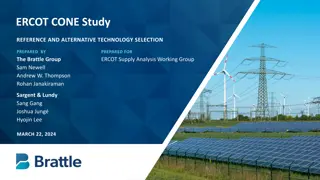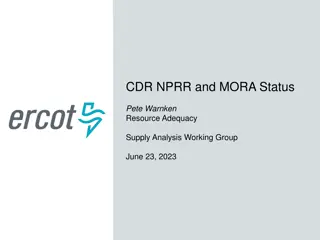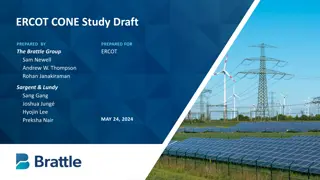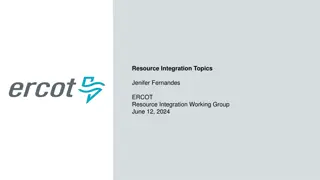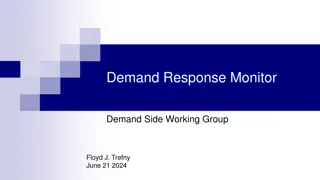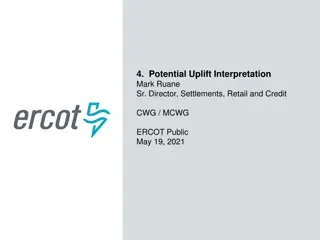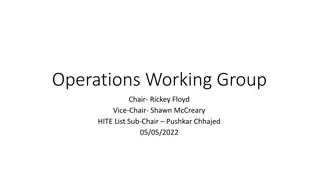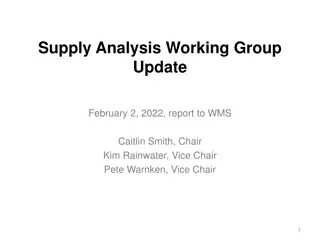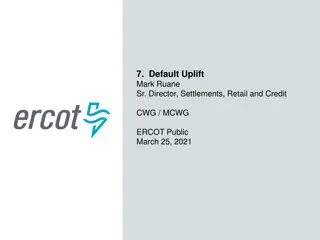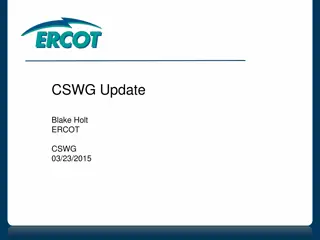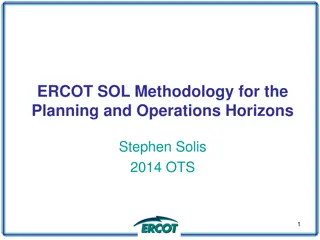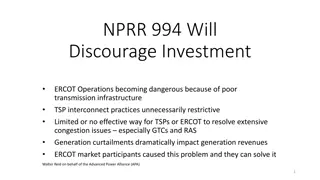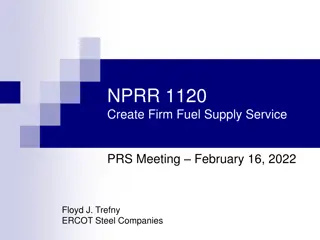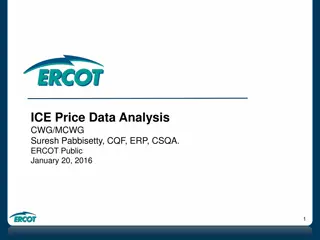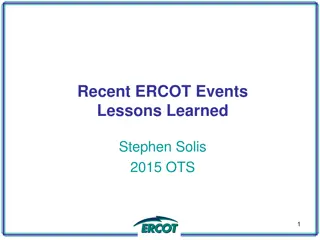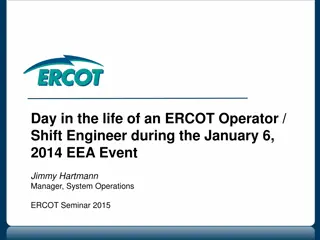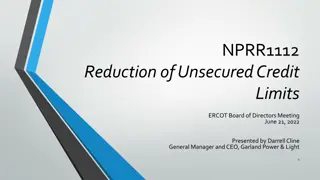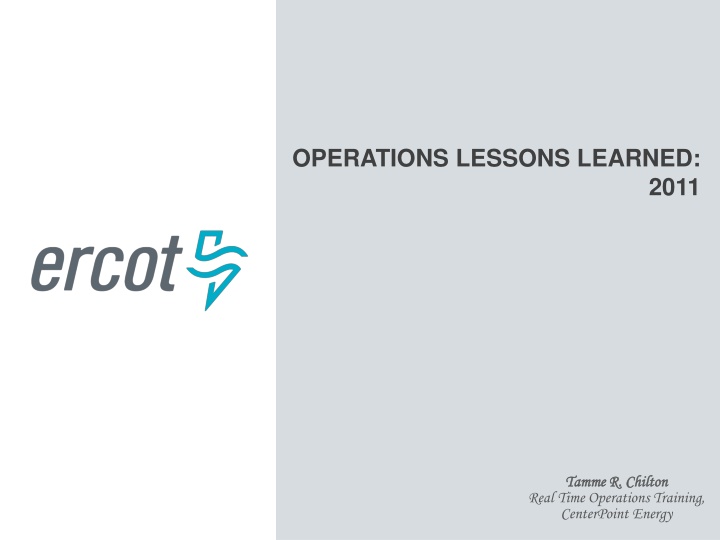
Lessons Learned from 2011 Southwest Cold Weather Event
In 2011, a rare cold weather event impacted the Southwest, revealing vulnerabilities in utilities. Key actions were taken to enhance winter operations, such as documenting minimum temperatures, inspecting facilities, and providing operator training. Objectives included identifying precursors and ensuring system reliability. The event had extreme conditions, with single-digit temperatures and high winds, necessitating careful monitoring and adherence to emergency procedures.
Download Presentation

Please find below an Image/Link to download the presentation.
The content on the website is provided AS IS for your information and personal use only. It may not be sold, licensed, or shared on other websites without obtaining consent from the author. If you encounter any issues during the download, it is possible that the publisher has removed the file from their server.
You are allowed to download the files provided on this website for personal or commercial use, subject to the condition that they are used lawfully. All files are the property of their respective owners.
The content on the website is provided AS IS for your information and personal use only. It may not be sold, licensed, or shared on other websites without obtaining consent from the author.
E N D
Presentation Transcript
OPERATIONS LESSONS LEARNED: 2011 Tamme R. Chilton Tamme R. Chilton Real Time Operations Training, CenterPoint Energy
OPERATIONS LESSONS LEARNED: 2011 While extreme cold weather events are not common in the Southwest, they do occur every few years. These events create significant impact in terms of dollars and human hardship. Many utilities have already undertaken improvements in light of their experiences during the February 1 5, 2011 event. *Source: Outages and Curtailments during the Southwest Cold Weather Event of February 1 5, 2011 2 PUBLIC
OPERATIONS LESSONS LEARNED: 2011 Some corrective actions implemented to improve winter operations include: Document minimum operating ambient temp on all generating and transmission facilities Inspect generating and transmission facilities for areas where water could collect and freeze Provide operators with more information and tools to aid in implementing rolling blackouts, as well as communicating with local agencies regarding outaged areas Train operators annually in winter- specific awareness, and conduct periodic drills to maintain their skills Review and modify Protocols as needed *Source: NERC Event Analysis Cause Codes Southwest Cold Weather Event of February 1 5, 2011 3 PUBLIC
OPERATIONS LESSONS LEARNED: 2011 OBJECTIVES Given a winter storm event: Identify precursors Determine actions necessary to maintain system reliability 4 PUBLIC
OPERATIONS LESSONS LEARNED: 2011 BLOCK 1 Precursors: Coldest Texas weather since 1989 Single-digit temps Sustained winds with 30-40 mph gusts ERCOT winter peak demand 56,344 MW 5 PUBLIC
OPERATIONS LESSONS LEARNED: 2011 BLOCK 2 Initial conditions: Senior Operator @ each group will Supervise Evaluate your system Review applicable procedures for Generation/Transmission/ERCOT preparations Determine general course of action 6 PUBLIC
OPERATIONS LESSONS LEARNED: 2011 BLOCK 2 Monitor expected path of Extreme Cold Weather Review Emergency Operating Procedures OCN 5 days ahead Advisory 3 days ahead Watch 1 day ahead Emergency Notice Coordinate with Outage Coordination Planned and existing outages Rejected, withdrawn, restored outages Coordinate with Operations Support Study for outage impacts Continue reviewing system conditions Implement procedures as needed 7 PUBLIC
600 MW Gas Unit 1 slack Base Case SUB-F TSP 2 Load 5 Load 4 A 32% MVA Line 6 Gas Unit 2 Tie Line 1 Load 1 SUB-D Line 3 Line 2 A A 600 MW 57% MVA 57% MVA Load 6 SUB-C SUB-B A 12% MVA A Condition: RTS: Line 11 32% MVA A 59% MVA Line 4 Line 7 Ln:11 OOS for Insulator Replacement 5 hrs Line 8 Line 1 Line 12 Line 9 A A 59% MVA 12% MVA A 36% MVA Ln: 2 Planned outage: Relay Maint. in 9 d N/A Line 13 Line 10 Gas Unit 3 SUB-A A A A 38% MVA 9% MVA 48% MVA 600 MW SUB-E SUB-G Line 5 SUB-H 1200 MW 0 MW Load 2 Nuclear Unit Load 3 Tie Line 2 Coal Unit 125 MW 125 MW Wind Units TSP 3 8 PUBLIC
Operating Condition Notice for Extreme Cold Weather This call requires everyone to remain on the line until it is complete. [TO] I will be asking you for the repeat back. This is ERCOT operator John Smith. At [xx:xx], ERCOT is issuing an OCN for an extreme cold weather system approaching [time frame] with temperatures anticipated to remain 32 F or below. TOs are instructed to: Review Planned outages and existing outages for the possibility of canceling or restoring equipment, Review and implement winterization procedures. Notify ERCOT of any changes or conditions that could affect system reliability. [TO] please repeat this back to me. This call requires everyone to remain on the line until it is complete. [QSE] I will be asking you for the repeat back. This is ERCOT Operator John Smith. At [xx:xx], ERCOT is issuing an OCN for an extreme cold weather system approaching [time frame] with temperatures anticipated to remain 32 F or below. QSEs are instructed to: Review fuel supplies, prepare to preserve fuel to best serve peak load, and notify ERCOT of any known or anticipated fuel restrictions, Review Planned Resource outages and consider delaying maintenance or returning from outage early, Review and implement winterization procedures. Notify ERCOT of any changes or conditions that could affect system reliability. [QSE] please repeat this back to me. 9 PUBLIC
Advisory for Extreme Cold Weather This call requires everyone to remain on the line until it is complete. [TO] I will be asking you for the repeat back. This is ERCOT operator John Smith. At [xx:xx], ERCOT is issuing an Advisory for the extreme cold weather system approaching [time frame] with temperatures anticipated to remain 32 F or below. TOs are instructed to: Review Planned outages and existing outages for the possibility of canceling or restoring equipment, Review and implement winterization procedures. Notify ERCOT of any changes or conditions that could affect system reliability. [TO] please repeat this back to me. This call requires everyone to remain on the line until it is complete. [QSE] I will be asking you for the repeat back. This is ERCOT operator John Smith. At [xx:xx], ERCOT is issuing an Advisory for the extreme cold weather system approaching [time frame] with temperatures anticipated to remain 32 F or below. QSEs are instructed to: Review fuel supplies, preserve fuel to best serve peak load, and notify ERCOT of any known or anticipated fuel restrictions, Review Planned Resource outages and consider delaying maintenance or returning from outage early, Review and implement winterization procedures. Notify ERCOT of any changes or conditions that could affect system reliability. [QSE] please repeat this back to me. 10 PUBLIC
Watch for Extreme Cold Weather This call requires everyone to remain on the line until it is complete. [TO] I will be asking you for the repeat back. This is ERCOT operator John Smith. At [xx:xx], ERCOT is issuing a Watch for the extreme cold weather system approaching [time frame]. Temperatures are expected to remain 32 F or below. TOs are instructed to: Review Planned outages and existing outages for the possibility of canceling or restoring equipment, Prepare for higher than usual loads, Review and implement winterization and emergency operating procedures. Notify ERCOT of any changes or conditions that could affect system reliability. [TO] please repeat this back to me. This call requires everyone to remain on the line until it is complete. [QSE] I will be asking you for the repeat back. This is ERCOT operator John Smith. At [xx:xx], ERCOT is issuing a Watch for the extreme cold weather system approaching [time frame]. Temperatures are expected to remain 32 F or below. QSEs are instructed to: Make available, any Resources that can be returned to service and keep COPs and HSLs updated, Review fuel supplies, preserve fuel to best serve peak load, and notify ERCOT of any known or anticipated fuel restrictions, Prepare for higher than usual loads and the possible need for additional Ancillary Services, Review and implement winterization and emergency operating procedures, including utilization of Resource pre-warming techniques. Notify ERCOT of any changes or conditions that could affect system reliability. [QSE] please repeat this back to me. 11 PUBLIC
Emergency Notice for Extreme Cold Weather This call requires everyone to remain on the line until it is complete. [TO] I will be asking you for the repeat back. This is ERCOT operator John Smith. At [xx:xx], ERCOT is issuing an Emergency Notice, the extreme cold weather system is beginning to have an adverse impact on the system such as [state what the adverse impacts are]. Prepare for higher than usual loads and the possibility of load shedding. ERCOT will continue to monitor the extreme cold weather system and will convey information and instructions as conditions warrant. [TO] please repeat this back to me. This call requires everyone to remain on the line until it is complete. [QSE] I will be asking you for the repeat back. This is ERCOT Operator John Smith. At [xx:xx], ERCOT is issuing an Emergency Notice, the extreme cold weather system is beginning to have an adverse impact on the system such as [state what the adverse impacts are]. QSEs are instructed to: Make Resources available that can be returned to service and keep COPs and HSLs updated, Keep ERCOT informed of known or anticipated fuel restrictions, Notify ERCOT of any changes or conditions that could affect system reliability. ERCOT will continue to monitor the extreme cold weather system. [QSE] please repeat this back to me. 12 PUBLIC
600 MW Gas Unit 1 slack T-24 SUB-F TSP 2 Load 5 Load 4 A 31% MVA Line 6 Gas Unit 2 Tie Line 1 Load 1 SUB-D Line 2 Line 3 A A 600 MW 58% MVA 64% MVA Load 6 SUB-C SUB-B Condition: RTS: Ln: 11 RTS N/A A Line 11 31% MVA A 59% MVA Ln: 12 OOS for Hot Spot Repair Unk Line 4 Line 7 Line 8 A Line 1 Line 12 12% MVA Line 9 A A 59% MVA 26% MVA A Nuke De-rate due to MFP failure Unk 36% MVA Coal Unit Commencing Start-Up 24 hrs Line 13 Line 10 Gas Unit 3 SUB-A A A A 38% MVA 12% MVA 41% MVA 600 MW SUB-E SUB-G Line 5 SUB-H 1200 MW 0 MW Load 2 Nuclear Unit Tie Line 2 Load 3 Coal Unit 125 MW 125 MW Wind Units TSP 3 13 PUBLIC
OPERATIONS LESSONS LEARNED: 2011 BLOCK 2 Supervisor Summary 14 PUBLIC
OPERATIONS LESSONS LEARNED: 2011 BLOCK 3 Transmission event: Senior Operator @ each group will Supervise Evaluate your system Review applicable procedures Identify system threats and determine response 15 PUBLIC
OPERATIONS LESSONS LEARNED: 2011 BLOCK 3 Review planned Transmission outages Evaluate Transmission capacity: Real Time Contingency Analysis (RTCA) System Operating Limits (SOL) Voltage Stability Limits (VSL) Generic Transmission Constraints (GTC) RAS, AMP, RAP, PCAP, MP, and TOAP Manage Transmission constraints: Capacity available to Security Constrained Economic Dispatch (SCED) Manual dispatch of Resources Diminishing Reserves Review TO Load Shed Obligation 16 PUBLIC
600 MW Gas Unit 1 slack T-0 SUB-F TSP 2 Load 5 Load 4 A 60% MVA Line 6 Gas Unit 2 Tie Line 1 Load 1 SUB-D Line 2 Line 3 A A 600 MW 71% MVA 64% MVA Load 6 SUB-C SUB-B Condition: RTS: A Line 11 23% MVA A 34% MVA Nuke Unit At half Output Unk Line 4 Line 7 Line 8 A Line 1 Line 12 11% MVA Line 9 A A 34% MVA 26% MVA A Coal Unit On-Line: Starting ramp from 0MW N/A 35% MVA Line 13 Line 10 Gas Unit 3 SUB-A A A A 30% MVA 11% MVA 41% MVA 600 MW SUB-E SUB-G Line 5 SUB-H 600 MW 0 MW Load 2 Nuclear Unit Tie Line 2 Load 3 Coal Unit 125 MW 125 MW Wind Units TSP 3 17 PUBLIC
600 MW Gas Unit 1 slack T+2 SUB-F TSP 2 Load 5 Load 4 A 60% MVA Line 6 Gas Unit 2 Tie Line 1 Load 1 SUB-D Line 3 A Line 2 A 105% MVA 81% MVA 600 MW SUB-C Load 6 SUB-B Condition: RTS: A Line 11 9% MVA A 48% MVA Coal Unit At dispatch N/A Line 4 Line 7 A Line 8 83% MVA Line 1 Line 12 Line 9 A A 48% MVA 37% MVA A 9% MVA Ln: 13 Trip on galloping Unk Line 13 Line 10 Gas Unit 3 SUB-A A A 1% MVA 13% MVA 600 MW SUB-E SUB-G Line 5 SUB-H 400 MW 200 MW Load 2 Nuclear Unit Tie Line 2 Load 3 Coal Unit 125 MW 125 MW Wind Units TSP 3 18 PUBLIC
680 MW Gas Unit 1 slack T+2 SUB-F TSP 2 Load 5 Load 4 A 78% MVA Line 6 Gas Unit 2 Tie Line 1 Load 1 SUB-D Line 3 Line 2 A A 81% MVA 90% MVA 520 MW SUB-C Load 6 SUB-B Condition: RTS: A Line 11 9% MVA A 48% MVA Coal Unit At dispatch N/A Line 4 Line 7 A Line 8 83% MVA Line 1 Line 12 Line 9 A A 48% MVA 37% MVA A 9% MVA Ln: 13 Trip on galloping Unk SCED Re-dispatch implemented N/A Line 13 Line 10 Gas Unit 3 SUB-A A A 1% MVA 13% MVA 600 MW SUB-E SUB-G Line 5 SUB-H 400 MW 200 MW Load 2 Nuclear Unit Tie Line 2 Load 3 Coal Unit 125 MW 125 MW Wind Units TSP 3 19 PUBLIC
Gas Unit 1 680 MW slack T+4 SUB-F TSP 2 Load 5 Load 4 A 78% MVA Line 6 Gas Unit 2 Tie Line 1 Load 1 SUB-D Line 3 Line 2 A A 520 MW 76% MVA 90% MVA Load 6 SUB-C A SUB-B 0% MVA Condition: RTS: A Line 11 10% MVA A 37% MVA Line 7 Line 4 Nuke Unit Continue Ramp Down Unk Line 8 A Line 1 Line 12 83% MVA A Line 9 A 37% MVA 37% MVA A 1% MVA Coal Unit Continue Ramp Up N/A Line 13 Line 10 Gas Unit 3 SUB-A A A 17% MVA 13% MVA 600 MW SUB-E SUB-G Line 5 SUB-H 200 MW 400 MW Load 2 Nuclear Unit Tie Line 2 Load 3 A Coal Unit 125 MW 125 MW 0% MVA Wind Units TSP 3 20 PUBLIC
Gas Unit 1 500 MW slack T+6 SUB-F TSP 2 Load 5 Load 4 A 37% MVA Line 6 Gas Unit 2 Tie Line 1 Load 1 SUB-D Line 3 A Line 2 103% MVA A 590 MW 64% MVA Load 6 SUB-C SUB-B Condition: RTS: A Line 11 16% MVA A 36% MVA Nuke Unit Stable Output Unk Line 7 Line 4 A Line 8 83% MVA Line 1 Line 12 A Line 9 A 36% MVA 36% MVA A Coal Unit Output @ max due to frozen coal Unk 5% MVA Gas Unit 1 Gas curtailed: Low line packing Unk Line 13 Line 10 Gas Unit 3 SUB-A A A 20% MVA 15% MVA 600 MW SUB-E SUB-G Line 5 SUB-H 200 MW 500 MW Load 2 Nuclear Unit Tie Line 2 Load 3 Coal Unit 125 MW 125 MW Wind Units TSP 3 21 PUBLIC
Gas Unit 1 500 MW slack T+8 SUB-F TSP 2 Load 5 Load 4 A 36% MVA Line 6 Gas Unit 2 Tie Line 1 Load 1 SUB-D Line 3 Line 2 A A 590 MW 63% MVA 75% MVA Load 6 SUB-C SUB-B Condition: RTS: Nuke Unit Stable Output Unk A Line 11 20% MVA A 42% MVA Line 4 Line 7 Coal Unit Output @ max due to frozen coal Unk Line 8 A Line 1 Line 12 0% MVA A Line 9 A 42% MVA 27% MVA A 12% MVA Gas Unit 1 Gas curtailed: Low line packing Unk Wind Units Trip on Over-Speed Unk Line 13 Gas Unit 3 Line 10 SUB-A A A 15% MVA 14% MVA 600 MW SUB-E SUB-G Line 5 SUB-H 0 MW 500 MW Load 2 Nuclear Unit Tie Line 2 Load 3 Coal Unit 0 MW 0 MW Wind Units TSP 3 22 PUBLIC
OPERATIONS LESSONS LEARNED: 2011 BLOCK 3 Supervisor Summary 23 PUBLIC
OPERATIONS LESSONS LEARNED: 2011 BLOCK 4 EEA event: Senior Operator @ each group will Supervise Evaluate your system Review applicable procedures Identify system threats and determine response 24 PUBLIC
OPERATIONS LESSONS LEARNED: 2011 BLOCK 4 See ERCOT Nodal Operating Guides: Section 4 Advisory: PRC < 3000MW Watch: PRC < 2500MW EEA Level 1: PRC < 2300MW and Not projected to recover within 30 minutes EEA Level 2: PRC < 1750MW or Unable to maintain frequency at a minimum of 59.91 Hz and Not projected to recover within 30 minutes EEA Level 3: PRC < 1375MW or Unable to maintain frequency at a minimum of 59.8 Hz and Not projected to recover within 30 minutes Frequency < 59.5 Hz, immediately implement EEA3 25 PUBLIC
PRC: 3000MW 26 PUBLIC
PRC: 2000MW 27 PUBLIC
This call requires everyone to remain on the line until it is complete. [TO] I will be asking you for the repeat back. This is ERCOT Operator John Smith; at [xx:xx], ERCOT is declaring EEA 1. [TO] please repeat this back to me. That is correct, thank you This call requires everyone to remain on the line until it is complete. [QSE] I will be asking you for the repeat back. This is ERCOT Operator John Smith. At [xx:xx], ERCOT is declaring EEA 1, QSEs are to perform their necessary steps for EEA 1. [QSE] please repeat this back to me. 28 PUBLIC
PRC: 1500MW 29 PUBLIC
This call requires everyone to remain on the line until it is complete. [TO] I will be asking you for the repeat back. This is ERCOT Operator John Smith, at [xx:xx], ERCOT is declaring EEA 2 and is issuing an appeal through the public news media for voluntary energy conservation. Reduce customer loads by using distribution voltage reduction measures, if deemed beneficial and any available capacity from Load Management Programs, [Load Resources and / or ERS have been deployed]. This call requires everyone to remain on the line until it is complete. [QSE] I will be asking you for the repeat back. This is ERCOT Operator John Smith, at [xx:xx], ERCOT is declaring EEA 2 and is issuing an appeal through the public news media for voluntary energy conservation. [Group 1 / Group 1 and 2] Load Resources have been deployed. Implement all measures associated with EEA 1, if not already implemented. [QSE] please repeat this back to me. 30 PUBLIC
Frequency: 59.48 31 PUBLIC
This call requires everyone to remain on the line until it is complete. [TO] I will be asking you for the repeat back. This is ERCOT Operator John Smith, at [xx:xx], ERCOT is declaring EEA 3. ERCOT is issuing an Operating Instruction for all Transmission Operators to shed their share of [amount] MW. Transmission Operators are to report to ERCOT when this is complete. Implement all measures associated with EEA 1 and 2, if not already implemented. [TO] please repeat this back to me. This call requires everyone to remain on the line until it is complete. [QSE] I will be asking you for the repeat back. This is ERCOT Operator John Smith, at [xx:xx], ERCOT is declaring EEA 3, [MW Amount] of firm load is being shed. Implement all measures associated with EEA 1 and 2, if not already implemented. [QSE] please repeat this back to me. 32 PUBLIC
OPERATIONS LESSONS LEARNED: 2011 BLOCK 4 Supervisor Summary 33 PUBLIC
OPERATIONS LESSONS LEARNED: 2011 WRAPUP Given a winter storm event: Identified precursors Determined actions necessary to maintain system reliability 34 PUBLIC

